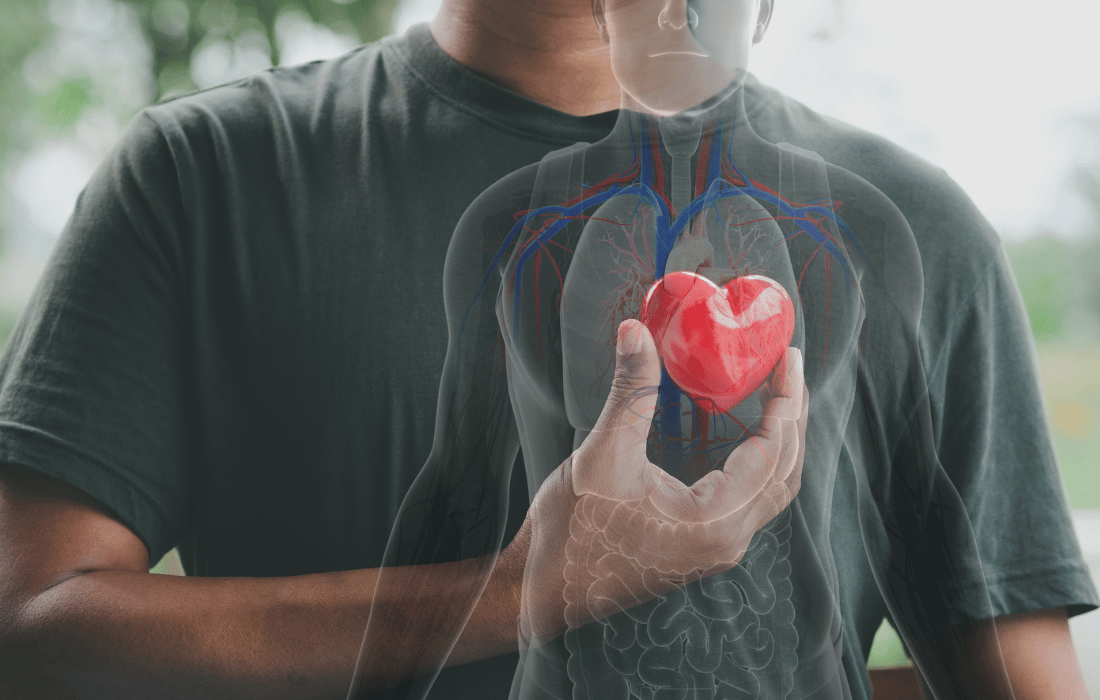Heart health—it’s something we all know we should be prioritizing, yet many men tend to put it on the back burner. With heart disease being the leading cause of death for men, the need to take proactive steps to protect our hearts couldn’t be clearer. The good news is that improving heart health doesn’t require a radical overhaul of your life. Instead, it’s about consistency in adopting a few key habits that holistically work together to strengthen your cardiovascular system.
However, there’s a catch: it’s not just about what you do, but also about what you don’t do. You could be crushing cold plunges or spending time in the sauna daily, but if you’re poisoning your body with processed foods, sugary drinks, or worse, you’re canceling out all the good. Equally important is paying attention to the hidden dangers in your environment—silent endocrine disruptors like chemicals in your food, indoor lighting, and even the radio frequencies surrounding us. A holistic approach means addressing everything that goes into (or around) your body. Let’s break it all down.
1. Cold Exposure: Shock Your System for Stronger Blood Vessels
 Cold exposure is one of the most underrated methods for boosting cardiovascular health. Whether it’s an ice bath, a cold plunge, or even just ending your shower with a blast of cold water, this practice forces your blood vessels to constrict and dilate rapidly, strengthening your circulatory system. Cold exposure also helps reduce inflammation, a major contributor to heart disease.
Cold exposure is one of the most underrated methods for boosting cardiovascular health. Whether it’s an ice bath, a cold plunge, or even just ending your shower with a blast of cold water, this practice forces your blood vessels to constrict and dilate rapidly, strengthening your circulatory system. Cold exposure also helps reduce inflammation, a major contributor to heart disease.
But consistency is key. It’s not about jumping into an ice bath once and calling it a day. The real benefits come when you make this a regular habit, especially when paired with other heart-healthy practices.
How to Start:
- Finish your regular shower with 60 seconds of cold water and gradually increase it to 2-3 minutes.
- Try ice baths or cold plunges after workouts for added benefits in recovery and circulation.
- Medical Disclaimer: Please watch the video below to learn safety measures when ice bathing to protect and strengthen your heart, not damage it!
2. Heat Exposure: Sauna for Cardiovascular Strength
While cold exposure is beneficial, heat exposure—especially via sauna sessions—can also be a game-changer for heart health. Regular sauna use has been linked to reduced risks of heart disease and stroke. By increasing your heart rate, dilating your blood vessels, and promoting circulation, saunas essentially give your heart a mini-workout. The bonus? Sweating it out in a sauna also promotes detoxification and reduces inflammation.
Again, the power of sauna use lies in consistent application. Using it once might feel great, but it’s the regular practice—combined with other habits—that truly helps fortify your cardiovascular system.
How to Start:
- Spend 10-15 minutes in a sauna 2-3 times per week to improve circulation and detoxification.
- Combine sauna sessions with cold exposure to boost heart resilience and recovery.
3. Walking: Simple, Yet Effective for Your Heart
Walking is the ultimate accessible exercise, but don’t let its simplicity fool you—it’s incredibly effective for heart health. Regular walking has been shown to lower blood pressure, improve cholesterol levels, and reduce the risk of heart disease. The beauty of walking is that you don’t need a gym or fancy equipment; it’s a habit you can integrate into your daily life with minimal effort.
But remember, it’s not about walking once or twice a week—it’s about making walking a part of your daily routine. Consistency is what transforms this easy activity into a cardiovascular powerhouse.
How to Start:
- Aim for at least 30-60 minutes of brisk walking each day.
- Break up your walking into smaller chunks throughout the day, like walking after meals to aid digestion and support heart health.
4. Zone 2 Cardio: The Heart’s Sweet Spot
Zone 2 cardio refers to moderate-intensity exercise that keeps your heart rate between 60-70% of your maximum. It’s the optimal zone for improving heart efficiency and endurance. Zone 2 cardio strengthens your aerobic system, helping your heart pump blood more effectively and reducing strain during both exercise and rest.
The key here, again, is regularity. Occasional high-intensity workouts aren’t bad, but consistency with Zone 2 cardio builds your heart’s resilience over time, making it stronger and more efficient at handling stress.
How to Start:
- Incorporate 30-45 minutes of Zone 2 cardio—like cycling, jogging, or swimming—2-3 times per week.
- Use a heart rate monitor to stay in the 60-70% range for maximum heart benefits.
5. Breathwork: Lower Stress, Strengthen Your Heart
Breathing is an automatic function, but when done consciously, it becomes a powerful tool for heart health. Techniques like diaphragmatic breathing can activate the parasympathetic nervous system, reducing heart rate and blood pressure while promoting relaxation. Breathwork can also increase oxygen flow to the heart, making it more efficient in its function.
The best part? Breathwork can be done anywhere—during a walk, while sitting at your desk, or before bed. But like everything else, it’s not a one-and-done deal. It’s the daily practice of mindful breathing that delivers long-term heart benefits.
How to Start:
- Set aside 5-10 minutes each day for intentional breathwork, such as box breathing (inhale for 4 seconds, hold for 4, exhale for 4, hold for 4).
- Integrate breathwork into stressful moments throughout the day to lower cortisol and give your heart a break.
6. Movement Snacks: Break Up the Sitting Cycle
Sitting for long periods and living a sedentary lifestyle increases your risk of heart disease, even if you’re otherwise physically active. The solution? Movement snacks—short bursts of activity throughout the day to keep your blood flowing and reduce the harmful effects of prolonged sitting. These snacks can be as simple as a quick walk around your office, a set of squats, or some stretching.
The goal is consistency. Movement snacks are about creating daily habits that keep your body (and heart) active, especially when you’re stuck in a sedentary work environment.
How to Start:
- Set a timer to remind yourself to stand up and move every 30-60 minutes.
- Incorporate small, simple movements like squats, lunges, or walking in place to keep your blood flowing and your heart happy.
7. Protect Your Heart from EMF with Aires Tech
In today’s world, we’re constantly surrounded by electromagnetic fields (EMFs) from our phones, Wi-Fi, and other electronic devices. Emerging research suggests that long-term exposure to EMFs can contribute to oxidative stress and inflammation, two factors that increase the risk of heart disease.
 Aires Tech EMF protection devices are designed to shield you from the potential harm of these invisible stressors. While it’s not practical to eliminate all exposure to EMFs, protecting yourself where you can—like your home, workplace, and personal devices—is a smart, proactive way to support your heart health.
Aires Tech EMF protection devices are designed to shield you from the potential harm of these invisible stressors. While it’s not practical to eliminate all exposure to EMFs, protecting yourself where you can—like your home, workplace, and personal devices—is a smart, proactive way to support your heart health.
How to Start:
- Use Aires Tech EMF protection on your phone, computer, and other electronics to reduce exposure throughout the day.
- Turn off Wi-Fi at night and avoid sleeping near electronics to give your body a break from EMFs while you rest.
8. Nourish Your Heart with Quality Animal Products
It’s not just about what you do for your heart—what you put into your body (and what you don’t) is equally crucial. High-quality animal products like organic grass-fed red meat, organic raw milk, and organic pasture-raised eggs are among the most nutrient-dense foods you can consume for heart health. These foods are rich in bioavailable protein, heart-healthy fats, vitamins, and minerals that support overall cardiovascular function.
Grass-fed red meat, for example, contains more omega-3 fatty acids and conjugated linoleic acid (CLA) than grain-fed beef, both of which reduce inflammation and support heart health. Organic raw milk is packed with probiotics and essential nutrients like calcium and magnesium, which are critical for healthy blood vessels and muscle function. Pasture-raised eggs are a powerhouse of vitamins B12, D, and K2—all crucial for maintaining heart and vascular health.
How to Start:
- Prioritize organic, grass-fed red meat, organic raw milk, and organic pasture-raised eggs in your diet.
- Eliminate processed foods and artificial ingredients, which not only harm your heart but can disrupt your endocrine system and overall health.
9. Avoid Endocrine Disruptors: What You Don’t Put In Matters
Here’s the kicker: a man can be doing everything right—cold plunges, sauna, clean eating—but still wreck his heart health by unknowingly exposing himself to toxic endocrine disruptors. These disruptors, often found in plastics, processed foods, fragrances, and even household products interfere with hormone function and contribute to cardiovascular disease.
We are surrounded by these silent killers in our food, our walls, indoor lighting, and even the daily dose of radio frequencies we trade-off to technology. These toxic compounds and EMFs increase inflammation, wreak havoc on your metabolism, and disrupt your body’s natural regulatory systems. It’s essential to take inventory of what’s in your environment and start minimizing your exposure.
How to Start:
- Use glass or stainless steel containers instead of plastic, especially for food storage.
- Opt for organic, non-toxic household cleaners, personal care products, and fragrances.
- Filter your drinking water and shower water to reduce exposure to pesticides, microplastics, and other chemicals.
10. Grounding: Connect with Nature to Heal Your Heart
Grounding, or earthing, is the practice of connecting your body directly to the earth’s surface by walking barefoot on grass, dirt, or sand. Research suggests that grounding can reduce inflammation, improve blood flow, and support overall cardiovascular function by allowing your body to absorb the earth’s natural electrons.
While the science behind grounding is still evolving, it’s a simple, low-effort habit that pairs well with other heart-healthy practices like walking or meditation. Plus, grounding helps reduce stress—a huge benefit for your heart.
How to Start:
- Spend 10-20 minutes each day walking barefoot on natural surfaces like grass, sand, or dirt.
- Combine grounding with a relaxing walk or stretch to enhance its heart-health benefits.
The Big Picture: Consistency and Clean Living Are Key
At the end of the day, heart health is all about consistency and balance. It’s not about doing one thing perfectly but about doing several things well, every day. Cold exposure, breathwork, or saunas are all great practices, but if you’re eating junk food or exposing yourself to toxic chemicals, you’re essentially undoing your hard work. The power of these habits lies in combining them and making them a regular part of your routine.
Don’t forget: it’s not just what you put into your body that matters—it’s also what you keep out. The hidden dangers of processed foods, endocrine disruptors, and harmful chemicals in your environment can have a profound effect on your heart health. By adopting a holistic approach and being mindful of both your actions and your surroundings, you can set yourself up for long-term heart health and overall well-being.
So start small, stay consistent, and remember that every healthy habit you adopt is a step toward a stronger, healthier heart.








